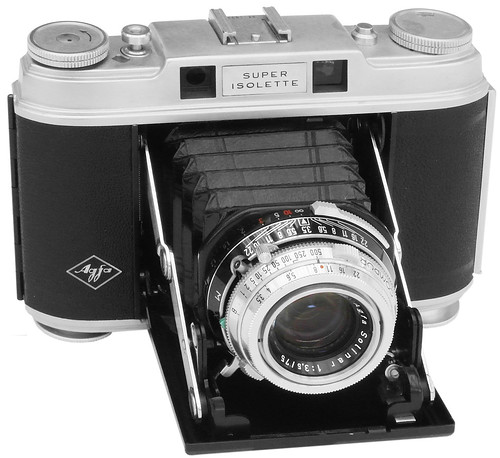Difference between revisions of "Super Isolette"
m (Minor design enhancement) |
m (→Description) |
||
| Line 14: | Line 14: | ||
The '''Super Isolette''' (sold as [[Ansco Super Speedex|Super Speedex]] in the US) was #2 in Agfa's folding medium format camera podium, with only the Agfa [[Automatic 66]] over it, this [[Agfa]] Automatic being world's first photographic camera with a real system for an automatic aperture priority - something not to be seen on medium format cameras until the release of Fuji's GA645. The Agfa [[Automatic 66]] was a really sophisticated camera, even more so Agfa could only manufacture it for barely two years. About 5,000 cameras were made, and now they are really collector's items | The '''Super Isolette''' (sold as [[Ansco Super Speedex|Super Speedex]] in the US) was #2 in Agfa's folding medium format camera podium, with only the Agfa [[Automatic 66]] over it, this [[Agfa]] Automatic being world's first photographic camera with a real system for an automatic aperture priority - something not to be seen on medium format cameras until the release of Fuji's GA645. The Agfa [[Automatic 66]] was a really sophisticated camera, even more so Agfa could only manufacture it for barely two years. About 5,000 cameras were made, and now they are really collector's items | ||
| − | The '''Super Isolette''' was always fitted with a 75/3.5 Solinar, the highest-grade lens offered among Agfa's folders. It was mounted on either a Synchro-Compur MX for the early units or a Synchro-Compur MXV fitted sometime during the production run (at | + | The '''Super Isolette''' was always fitted with a 75/3.5 Solinar, the highest-grade lens offered among Agfa's folders. It was mounted on either a Synchro-Compur MX for the early units or a Synchro-Compur MXV fitted sometime during the production run (somewhere at the 7xxx mark). In any event, these shutters are flash synched at all speeds. Lens can receive either 32mm slip-on filters, or 29.5mm screw-in filters. |
Unit focusing, 4-element Tessar-like lens, fast shutter, automatic frame counter, semi-automatic film loading system, double exposure prevention mechanism, coupled rangefinder... All these features make the Super Isolette a sought-after camera even today. | Unit focusing, 4-element Tessar-like lens, fast shutter, automatic frame counter, semi-automatic film loading system, double exposure prevention mechanism, coupled rangefinder... All these features make the Super Isolette a sought-after camera even today. | ||
| − | |||
==Notes== | ==Notes== | ||
Revision as of 23:05, 27 December 2012
The Super Isolette provides 6×6 cm pictures on 120 film and was manufactured by Agfa from 1954-60.[1]. "Super" refers to the addition of a coupled rangefinder; it was the base for copies made abroad such as the Iskra and is a redesign of the Isolette III - which has an uncoupled rangefinder - and other Isolettes which are viewfinder cameras.
Description

|
| image by Alf Sigaro (Image rights) |
The Super Isolette (sold as Super Speedex in the US) was #2 in Agfa's folding medium format camera podium, with only the Agfa Automatic 66 over it, this Agfa Automatic being world's first photographic camera with a real system for an automatic aperture priority - something not to be seen on medium format cameras until the release of Fuji's GA645. The Agfa Automatic 66 was a really sophisticated camera, even more so Agfa could only manufacture it for barely two years. About 5,000 cameras were made, and now they are really collector's items
The Super Isolette was always fitted with a 75/3.5 Solinar, the highest-grade lens offered among Agfa's folders. It was mounted on either a Synchro-Compur MX for the early units or a Synchro-Compur MXV fitted sometime during the production run (somewhere at the 7xxx mark). In any event, these shutters are flash synched at all speeds. Lens can receive either 32mm slip-on filters, or 29.5mm screw-in filters.
Unit focusing, 4-element Tessar-like lens, fast shutter, automatic frame counter, semi-automatic film loading system, double exposure prevention mechanism, coupled rangefinder... All these features make the Super Isolette a sought-after camera even today.
Notes
- ↑ McKeown, James M. and Joan C. McKeown's Price Guide to Antique and Classic Cameras, 12th Edition, 2005-2006. USA, Centennial Photo Service, 2004. ISBN 0-931838-40-1 (hardcover). ISBN 0-931838-41-X (softcover). p25.
Links
In English:
- Super Isolette profiled among other Agfa/Ansco folders, by Andrew Yue
- Notes on the Super Isolette and PDF User's manual for it at Certo6.com.
- Agfa Super Isolette on Pocketable History by J. Noir
In Spanish:
- Agfa Super Isolette on Historia de Bolsillo by J. Noir